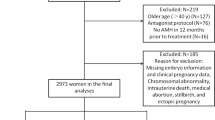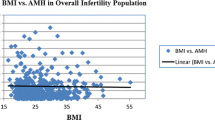Abstract
Background
Pregnant PCOS patients were found to suffer from many adverse outcomes of pregnancy. Prediction of the fate of pregnancy and labor in PCOS patients was highly needed. There were recently discovered roles of serum AMH in those patients who were seeking for pregnancy and who were conceiving with assisted reproductive techniques.
Aim
To analyze the predictive roles of measuring serum levels of AMH in patients with PCOS who became pregnant spontaneously or used assisted reproductive techniques regarding abortion and preterm delivery.
Patients and Study Design
A total of 100 females with PCOS were included in the study and they underwent assisted reproductive techniques were included in the study and underwent measurement of AMH levels regularly.
Results
We found that a total of 70 patients had a term delivery, and 30 patients had a preterm delivery. We found no statistically significant differences between both groups regarding their age or body mass index (BMI). We showed that serum AMH levels were higher in the group of PCOS patients who had preterm delivery than in the group of patients with term delivery (p < .0.001).
Conclusions
High serum AMH levels were found to be associated with higher risks of occurrence of preterm labor in patients with PCOS who underwent assisted reproductive techniques. Our results gave a clue to clinicians for better management of the pregnancy process in these patients.
Similar content being viewed by others
References
Hu KL, Liu FT, Xu H, et al. High antim€ullerian hormone levels are associated with preterm delivery in patients with polycystic ovary syndrome. Fertility Sterility. 2019;113:444.
Roos N, Kieler H, Sahlin L, et al. Risk of adverse pregnancy outcomes in women with polycystic ovary syndrome: population based cohort study. BMG. 2011;343:6309.
Palomba S, de Wilde MA, Falbo A, et al. Pregnancy complications in women with polycystic ovary syndrome. Hum Reprod Update. 2015;21:575–92.
Cate RL, Mattaliano RJ, Hession C, t al. Isolation of the bovine and human genes for Mullerian inhibiting substance and expression of the human gene in animal cells. Cell. 1986;45:685–98.
Dewailly D, Robin G, Peigne M, et al. Interactions between androgens, FSH, anti-Mullerian hormone and estradiol during folliculogenesis in the human normal and polycystic ovary. Hum Reprod Update. 2016;22:709–24.
Dewailly D, Andersen CY, Balen A, et al. The physiology and clinical utility of anti-Mullerian hormone in women. Hum Reprod Update. 2014;20:370–85.
Hart R, Doherty DA, Norman RJ, et al. Serum antimullerian hormone (AMH) levels are elevated in adolescent girls with polycystic ovaries and the polycystic ovarian syndrome (PCOS). Fertil Steril. 2010;94:1118–21.
Tal R, Seifer DB, Khanimov M, et al. Characterization of women with elevated antimullerian hormone levels (AMH): correlation of AMH with polycystic ovarian syndrome phenotypes and assisted reproductive technology outcomes. Am J Obstet Gynecol. 2014;211:59.
Fong LS, Laven JSE, Duhamel A, et al. Polycystic ovarian morphology and the diagnosis of polycystic ovary syndrome: redefining threshold levels for follicle count and serum anti-Mullerian hormone using cluster analysis. Hum Reprod. 2017;32:1723–31.
Fraissinet A, Robin G, Pigny P, et al. Use of the serum anti-Mullerian hormone assay as a surrogate for polycystic ovarian morphology: impact on diagnosis and phenotypic classification of polycystic ovary syndrome. Hum Reprod. 2017;32:1716–22.
Mumford SL, Legro RS, Diamond MP, et al. Baseline AMH level associated with ovulation following ovulation induction in women with polycystic ovary syndrome. J Clin Endocrinol Metab. 2016;101:3288–96.
Tata B, Mimouni NEH, Barbotin AL, et al. Elevated prenatal anti-Mullerian hormone reprograms the fetus and induces polycystic ovary syndrome in adulthood. Nat Med. 2018;24:834–46.
Goldenberg RL, Culhane JF, Iams JD, et al. Epidemiology and causes of preterm birth. Lancet. 2008;371:75–84.
Rotterdam ESHRE/ASRM-Sponsored PCOS Consensus Workshop Group. Revised 2003 consensus on diagnostic criteria and long-term health risks related to polycystic ovary syndrome. Fertil Steril. 2004;81:19–25.
Chi H, Qiao J, Li H, et al. Double measurements of serum HCG concentration and its ratio may predict IVF outcome. Reprod Biomed Online. 2010;20:504–9.
Xu H, Zeng L, Yang R, et al. Retrospective cohort study: AMH is the best ovarian reserve markers in predicting ovarian response but has unfavorable value in predicting clinical pregnancy in GnRH antagonist protocol. Arch Gynecol Obstet. 2017;295:763–70.
Hsu JY, James KE, Bormann CL, et al. M€ullerian inhibiting substance/antim€ullerian hormone as a predictor of preterm birth in polycystic ovary syndrome. J Clin Endocrinol Metab. 2018;103:4187–96.
Author information
Authors and Affiliations
Corresponding author
Ethics declarations
Conflict of interest
We have no financial interest or conflict of interest in association with this work.
Ethical standard
Approval for making the study from the local ethical committee of Faculty of Medicine, Zagazig University.
Additional information
Publisher's Note
Springer Nature remains neutral with regard to jurisdictional claims in published maps and institutional affiliations.
Walid A. Abdelsalam is an Assistant Professor of Gynecology and Obstetrics, Faculty of Medicine, Zagazig University, Zagazig, Egypt; Ola A. Harb is an Assistant Professor of Pathology, Faculty of Medicine, Zagazig University Zagazig, Egypt; Sherin A. Shazly is an Assistant Professor of Gynecology and Obstetrics, Faculty of Medicine, Zagazig University, Zagazig, Egypt.
Rights and permissions
About this article
Cite this article
Abdelsalam, W.A., Harb, O.A. & Shazly, S.A. Antimullerian Hormone Levels and Association with Abortion and Preterm Delivery in Patients with Polycystic Ovary Syndrome Who Conceived with Assisted Reproductive Techniques. J Obstet Gynecol India 72 (Suppl 1), 295–298 (2022). https://doi.org/10.1007/s13224-021-01506-w
Received:
Accepted:
Published:
Issue Date:
DOI: https://doi.org/10.1007/s13224-021-01506-w




